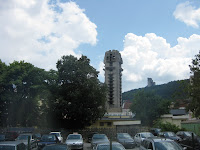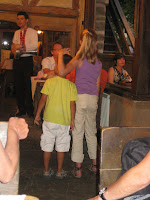Hello! Today was a very informational day: we started by having lectures on Bulgarian history, economics, and politics. Then after lunch we had a walking tour of Sofia. Let me tell you a bit about what I learned today.

First, the most interesting thing, is that of the name of the city. Remember a few days back when I blogged about how to pronounce Sofia? I told you the accent was on the "o". This is true when talking about the place, but I found out that Bulgarians pronounce Sophia with the accent on the "i" if referring to a person's name. The picture that you see to the left is Saint Sophia (accent on the "i"). This statue is in the main plaza in downtown Sofia, right next to the Parliament building and Presidential Offices. At the Presidential Offices stand two guards...I was lucky enough to see the changing of the guards while standing in front of the building. I am SO glad I'm not them though...they have to wear wool suits with big feather-y hats. And Keisha -- the weather here is hot! Not as hot as Greece, but we are still pretty close to the sun and it gets scorching hot out!

Across the street from the Presidential Offices is this white columned building. On the top of the building is the Bulgarian flag (a white strip, followed by a green strip, followed by a red strip). This was the old headquarters of the Communist Regime. The building used to have a large red star at the top of it, but a helicopter came by and whisked it away...no one knows where it is now (well, I guess at least one person has to know where it is!!!). I love the intrigue!
Sofia is also known in Bulgaria as having the best colleges. All public colleges are free because of the Communist influence. One college of

great importance is the Art College (where Ms. Lina attended school). The school is very prestigious, since only 5 art students are accepted each year. Throughout our tour of Sofia we saw many students sitting in the parks sketching the buildings around Sofia. I took a picture of three of them sitting by the fountains and sketching the Theatre building.
Sofia is a great walking city...it's easy to navigate and very beautiful...there are lots of trees, cobble stone paths, and gardens. But let me tell you a bit more about Bulgaria in general:
Sofia has been very influenced by the Ottoman Turks and much of the architecture looks Eastern. Also because the Turks ruled Bulgaria for over 500 years, there are many mosques here in the city (a little over 100). Ever since Bulgaria gained their independence (April 16, 1876) from the Turks, though, they have converted many of the mosques into other buildings. (The national religion is Orthodox). In a few days I will be visiting the Archeological Museum, which used to be a large mosque...so I'll show you a picture of that in a few days. Also, an interesting side note: the Christians during Turk reign were able to continue to practice their religion, but their churches could not be taller than a man on horseback. So many of the churches are very squat...or even were partially built underground so they would be short. While there are not as many Turks in Bulgaria, there is still a Turkish Party in the political system, who are called the "Movements of Rights and Freedoms".
A question for you: Do you think Turkey should become part of the European Union?
This question has been partially answered today in our lectures, although I will learn more about it tomorrow and will blog on it later. I'd be interested in your comments though.
Finally let me tell you a bit about the economic situation here in Bulgaria. You already know that salaries are very low here. This has created a problem since Bulgaria is now part of the EU and will go on the Euro January 2009. Inflation is at 15% right now and unemployment is at 8%. This is not necessarily bad...it seems natural for the country to be slightly unstable because of the transition into the EU...but people here are very worried about it. The GPD per person is only about $11,000, though.
Another problem in Bulgaria is the fact that the population is slowly disappearing. There are about 7.6 million people in Bulgaria and there are many deaths and a low birth rate. Also, many young educated people are moving to England, France, or German when they graduate college. This may be because in Communism, everything was provided for the people and so you were poor -- but everyone was poor. Now a days with democracy, there are a lot of poor people and a few rich people. I don't know how Bulgaria will solve this...although our lecturer today was very positive that Bulgaria only needs more time in the EU and then will be following the path similar to Hungry, Poland, and Romania.
Bulgaria is a beautiful country though...I'm looking forward to going to the Black Sea coast. I have already heard many Bulgarians talking about it and telling me that it is definitely a resort area and a great vacation spot for most Bulgarians.
Jimothy -- A Bulgarian person definitely knows all about their country's history. The people here are very friendly and nice. If you came, you could expect to find people ready and willing to help you at all times!
Marbella -- Many of the families here stick closely together if possible; meaning they include grandparents as well. BUT since there has been so much economic despair, families in the rural areas end up sending their son or daughter here to Sofia (the capital) to get a good education. That means the child is sent to a boarding house, has a landlord who cooks for them, or lives by themselves. This is definitely a hardship on the kids.
Alright...sorry I wrote so much. I'm learning lots and want to share it with you, though!
Cheers!




























 great importance is the Art College (where Ms. Lina attended school). The school is very prestigious, since only 5 art students are accepted each year. Throughout our tour of Sofia we saw many students sitting in the parks sketching the buildings around Sofia. I took a picture of three of them sitting by the fountains and sketching the Theatre building.
great importance is the Art College (where Ms. Lina attended school). The school is very prestigious, since only 5 art students are accepted each year. Throughout our tour of Sofia we saw many students sitting in the parks sketching the buildings around Sofia. I took a picture of three of them sitting by the fountains and sketching the Theatre building.























